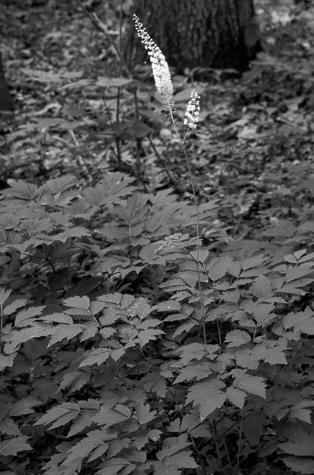BLACK COHOSH
Botanical name: Actaea racemosa syn. Cimicifuga racemosa
Synonyms: Black bugbane; Black snakeroot
PRINCIPAL USES
TRADITIONAL AND HISTORICAL USES
with tenderness, false pains, irregular pains, rheumatism of the uterus, dysmenorrhea.” They also recognized its value as a superb sedative. It was considered to have particular affinities for the uterus, heart, and circulatory system, supposedly improving (cardiac) contractile force; however, this indication has not been widely studied nor borne out by limited scientific evaluation of the plant. It was considered a reliable herb to aid in birth and relieve pain afterward, given in small doses before, during, and after labor. Its effects for the treatment of all manner of musculoskeletal and neuralgic pains were widely reputed. Listed in the USP from 1820 until 1920, it was and continues to be one of the most popular herbal medicines sold in Western nations.
CLINICAL INDICATIONS
Black cohosh is the most widely sold and used herb in western nations for the treatment of perimenopausal neurovegetative complaints. It is commonly used for such by herbal practitioners and research has largely centered on its use for these purposes. Herbal practitioners also use black cohosh as a reliable anti-inflammatory, antispasmodic, and analgesic for all manner of neuromuscular complaints, for premenstrual headache, as well as for treating spasmodic or paroxysmal coughs. Plant Profile Black Cohosh Table 2 lists the uses of this herb by contemporary herbalists and naturopathic physicians.
TABLE 2 Common Uses of Black Cohosh in Modern Herbal Practice
| Dysmenorrhea |
| Ovarian pain |
| Neurovegetative menopausal symptoms: hot flashes, reduction of sweating, headache, heart palpitations, anxiety, nervousness, insomnia, irritability, depression (for the latter in combination with Hypericum perforatum (St. John’s wort), and possibly vaginal dryness and atrophy |
| Musculoskeletal pain; i.e., myalgia, sciatica, arthritis, neuralgia |
| Premenstrual migraine |
| Cough |
| Osteoporosis |
| Possible additional indications include |
| Uterine contractions in threatened miscarriage (see Use in Pregnancy and Lactation) |
TABLE 1 Black Cohosh for Gynecologic and Obstetric Problems: Eclectic Medical Uses
| Treat uterine and ovarian neuralgia |
| Antispasmodic for generalized and uterine “rheumatic” pains |
| Uterine irritability |
| Irritated and congested pelvic conditions |
| Amenorrhea |
| Dysmenorrhea |
| Hysteria |
| Relieves irregular pains and uterine contractions |
| Partus accelerator |
| Partus preparator |
| Postpartum hemorrhage |
| Relaxes the soft parts of the parturient canal and facilitates delivery |
| Relieves insomnia, relieves reflex irritability thus quieting morning sickness |
| Relieves spasmodic pains of early labor and due to its relaxing effects, reduces laceration at birth |
| Maintains uterine contraction after birth |
< div class='tao-gold-member'>




